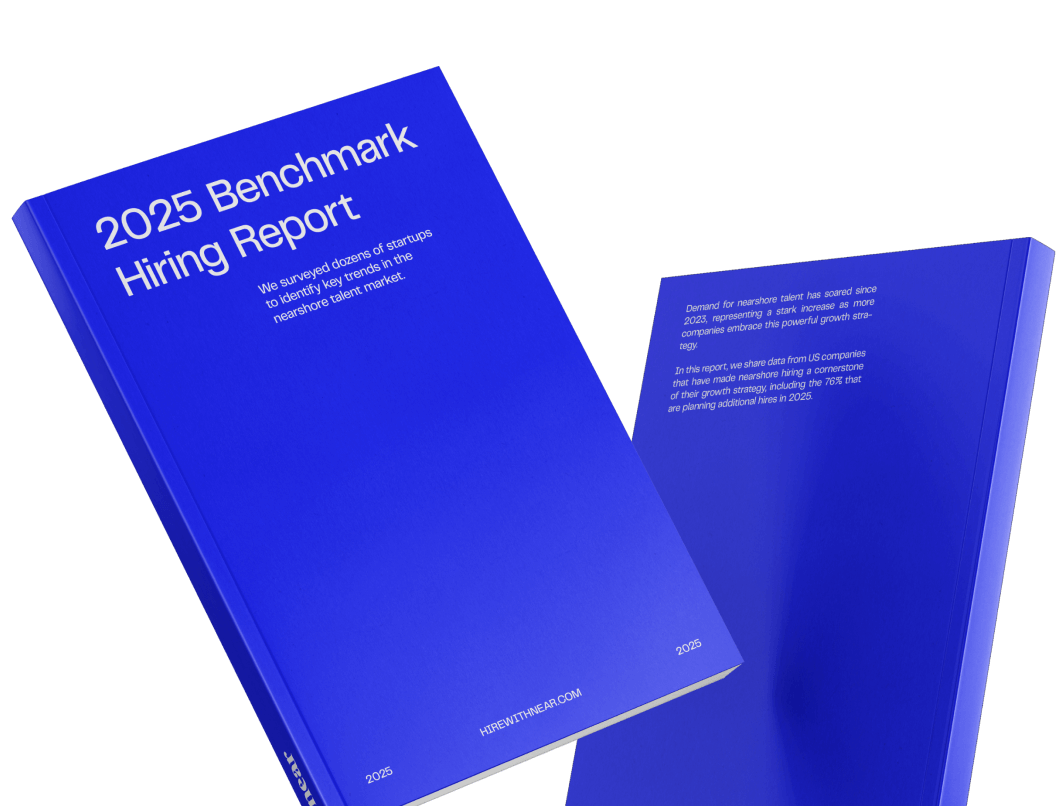Key Takeaways
- Partnering with a nearshore provider in Mexico gives you access to a technically proficient talent pool within a thriving tech industry that offers highly competitive rates.
- A successful nearshore partnership requires finding the right nearshore partner, defining clear expectations, and managing projects carefully.
- While other Latin American countries like Argentina, Colombia, and the Dominican Republic also have strong IT industries, Mexico stands out for its high level of English proficiency, convenient time zones, and pool of skilled developers.
Nearshore software development in Mexico is becoming increasingly popular among employers looking for top-notch software engineers and other IT talent at affordable rates.
With its geographical proximity to the United States, shared time zones, and highly skilled workforce, Mexico has become a preferred nearshore destination for outsourcing software development projects.
In this article, we will explore the key benefits of working with a nearshore software development company in Mexico.
We’ll also offer guidance on building and maintaining a successful working relationship with your nearshore provider and compare nearshore software development companies with those in other Latin American countries.
What Is Nearshore Software Development?

Nearshore outsourcing is when you delegate certain business processes or roles to a provider in a nearby country, typically one in a similar time zone.
Companies in the United States are increasingly choosing to outsource tasks like software development to nearshore countries like Mexico over offshore regions like China due to the wide range of benefits this approach provides.
Below, we’ll cover each of the advantages of nearshoring software development to a company in Mexico.
Why Choose a Nearshore Software Development Company in Mexico?
Tapping into the talent pools of nearshore software development companies in Mexico can bring numerous benefits to your business.
Strong IT and software development industry
Mexico is home to a thriving IT and software development industry, with many top universities offering degrees in computer science and engineering. This has resulted in a large pool of highly skilled talent that can provide quality nearshore development services for your software projects.
Skilled workforce
IT professionals in Mexico are well educated and have a strong work ethic, making them an ideal fit for companies looking for reliable and dedicated remote team members.
They also possess a good understanding of cutting-edge technologies and trends in software development, ensuring that your projects are completed using the most up-to-date and efficient methods.
Geographic proximity and time zone advantages
Mexico’s proximity to the United States means minimal time zone differences, as there are multiple overlapping time zones. This makes communication and collaboration easier for employers. It also allows for quicker response times and faster project completion.
Cost savings
Nearshore software development companies in Mexico can offer cost-effective solutions for your IT needs.
We find that mid-level developers in Mexico earn around $50,000 to $70,000 annually. This is considerably less expensive than the average salary of the same role in the United States, which can exceed $100,000.
With lower labor costs than in the United States and other European countries, you can save on expenses while still receiving high-quality services.
How To Have a Successful Partnership With a Nearshore Software Development Company in Mexico
When looking for a nearshore development company in Mexico, it’s important to consider the following factors as they relate to your company and culture.
Find the right nearshore development partner for your business
Look for a company with extensive experience working on similar projects in your industry. Consider the size of the company and if its nearshore software development services align with your project needs.
Although cost savings shouldn’t be your only concern, make sure you understand its pricing models and whether the expenses match your budget.
Additionally, assess whether its software development team aligns with your company culture and has strong communication skills to ensure streamlined collaboration.
Set clear expectations
Clearly define project goals, timelines, and deliverables. Discuss communication methods and preferred tools for project management. Don’t forget to establish a plan for addressing any potential language or cultural differences.
Manage projects effectively
Once you’ve chosen the right provider and laid out your business requirements, continue to monitor performance carefully.
Regularly check in with your nearshore team and provide timely feedback. Utilize project management tools to track progress and identify any roadblocks. Encourage open communication and collaboration between your in-house team and the nearshore software developers.
Nearshore Software Development Companies in Mexico vs. Other Latin American Countries
There are several other countries in Latin America that companies turn to for nearshoring software development, including Argentina, Brazil, Colombia, and more.
While these countries each have their strengths, Mexico has emerged as a top choice for many employers due to its unique advantages.
It’s important to note that while many countries in Latin America have a higher overall proficiency in English according to the EF English Proficiency Index, Mexico has the highest total number of English speakers, thanks to its large population, Western influences, and close ties with the United States.
Therefore, it offers a large pool of English-speaking software developers from which to choose.
Below, we’ll show you how Mexico stacks up against these nations based on factors like language proficiency, time zones, and development talent.
Mexico vs. Argentina
- Language proficiency: While both countries have a high number of English speakers, Argentina has a higher overall proficiency in the language, being ranked 28th globally.
- Time zones: Argentina’s time zone does not directly align with the United States, whereas three of Mexico’s time zones overlap with parts of the US. This makes the latter more convenient for real-time communication and collaboration with US-based teams.
- Development talent: Both countries have a large pool of highly skilled developers. However, Mexico’s IT industry is more established and experienced.
Mexico vs. Brazil
- Language proficiency: Portuguese is the official language of Brazil; however, it has slightly higher English proficiency rates than Mexico.
- Time zones: None of Brazil’s time zones directly overlap with the US year-round, making Mexico more convenient for real-time collaboration with US teams.
- Development talent: While both countries have a strong IT industry, Mexico has a larger pool of experienced developers due to its longer history in software development outsourcing.
Mexico vs. Colombia
- Language proficiency: Spanish is the official language of both countries, but Colombia has a slightly higher English proficiency.
- Time zones: Though Colombia’s time zone aligns with US Eastern Standard Time, there is a one-hour difference during daylight saving time. In comparison, Mexico’s time zones have a wider overlap with the US.
- Development talent: While Colombia’s IT industry is rapidly growing, it does not yet have the same experience and expertise as Mexico.
Mexico vs. Chile
- Language proficiency: Chile has a higher percentage of English speakers than Mexico, but Spanish is still the primary language.
- Time zones: While there are partial overlaps between time zones in Chile and the US during part of the year, Mexico has more time alignment with the US.
- Development talent: While Chile has a growing IT industry, Mexico’s longer history of software development outsourcing gives the country an edge in terms of experienced developers.
Mexico vs. Peru
- Language proficiency: Spanish is the official language of both countries, but Peru currently scores higher in English proficiency than Mexico.
- Time zones: Though Peru’s time zone aligns with Eastern Standard Time and Central Daylight Time in the US, Mexico offers more alignment overall, as multiple time zones overlap with parts of the US.
- Development talent: While Peru has a growing IT industry, Mexico’s longer history and established reputation in software engineering outsourcing make it a more reliable choice for employers.
Mexico vs. the Dominican Republic
- Language proficiency: Compared with Mexico, the Dominican Republic has a higher level of English proficiency.
- Time zones: The Dominican Republic is in the Atlantic Time Zone, making it slightly less convenient for real-time collaboration with US teams.
- Development talent: While both countries have a growing IT industry, Mexico has more established companies and experienced developers.
Mexico vs. Cuba
- Language proficiency: Cuba has a higher level of English proficiency than Mexico.
- Time zones: While Cuba shares the same time zone as the US, its internet infrastructure and connectivity can be unreliable at times.
- Development talent: Mexico has a larger pool of experienced developers due to its thriving IT industry.
Mexico vs. Bolivia
- Language proficiency: Bolivia has a higher overall English proficiency than Mexico.
- Time zones: Bolivia’s time zone does offer some alignment with the US, but Mexico offers a wider overlap spanning several time zones.
- Development talent: While Bolivia also has a growing IT industry, Mexico’s industry is more developed and offers a larger pool of experienced developers.
In summary, while there are other Latin American countries with strong IT industries and high overall English proficiency, Mexico stands out for its large number of English speakers, convenient time zones for US collaboration, and large pool of tech talent.
Final Thoughts

Nearshore software development companies in Mexico offer a compelling solution for employers seeking top tech talent at cost-effective rates. With its skilled workforce, cultural compatibility, and convenient location, Mexico has become a go-to nearshore destination for outsourcing software projects.
As a remote hiring company specializing in Latin America, Near can help you tap into this pool of highly qualified tech professionals and take your development to the next level.
Schedule a free consultation call today and learn more about how we can help you find the right nearshore software development company in Mexico for your specific needs and business goals.













.png)






%20(1).png)
%20(1).png)
